

 |
||
 |
||
Vol. 12 (2): November 2009 |
||
Croatia / Greece / Madeira / Mauritania & Western Sahara / Turkey
Madeira
|
||||||||||||||||||||||||
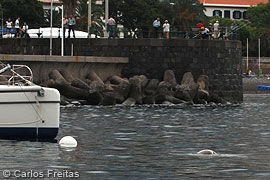 |
|
|
Monk seal 'Marina' (bottom right). |
Ever since May, the PNM Service has been receiving sightings reports of a young seal in different areas around Funchal, mainly in the beach complexes and the marina. Because of this the Madeira people have taken to calling the seal “Marina”.
Most of the reports describe “Marina” as resting on the sea, though on two occasions it was observed sleeping in the sea under a catamaran, and in other two other instances, resting on an artificial platform for bathers. But there are also sightings of the seal playing with a boy, and hunting inside the marina. Though on most occasions the seal was observed alone, it was also observed with an adult, probably its mother.
The observations were made by lifeguards, sailors and the general public. Some of the sightings were also made by PNMS staff. The question that most people ask is an obvious one: why has this seal chosen to stay in Madeira’s most heavily-populated area? And the probable answer is:
Indeed, the public reaction so far has been mainly one of surprise, and concern for the animal. Maybe humans and seals can finally live together. – Rosa Pires, Parque Natural da Madeira Service.
With the welcome return of the species to Madeira island, monk seals have started using areas used by humans for recreational purposes, in one case, a cave that is also a favourite of scuba divers. In fact visits through the entranceway to this particular cave are on the programmes of several Madeiran diving centres.
The entrance is 10m deep, the cave 35m long and 15m wide. At the far end of the cave it is possible to ascend to an air filled chamber. This is the area used by the monk seals to breathe.
The use of this cave by both seals and scuba divers has resulted in some scuba divers being bitten and disturbance to the seals themselves. Considering these factors and wishing to minimise any negative impacts both to monk seals or diving activity, the Parque Natural da Madeira Service met with all stakeholders involved with the aim of establishing a cave use code. This occurred on 8 June at the headquarters of Garajau Nature Reserve, where the 7 diving centres using the cave were represented.
In forming the use code, it was established that dive visits to the cave should not exceed one per day and should always be accompanied by a guide, responsible for guiding the group, which should not exceed 6 persons (including guides). If any seal is found to be in the cave at the time, the distance to the animal should be maintained; use of flashlights should be kept to the minimum possible; camera flashes should not be used, and the visitors should withdraw from the cave. – Rosa Pires, Parque Natural da Madeira Service.
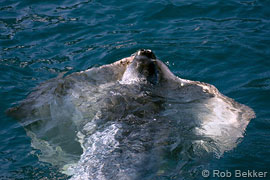 |
|
|
Courtesy: Rob Bekker / http://www.robbekker.com |
Well this is a question that only came about after an extraordinary sighting from the sailing boat charter “Gavião” in Madeira. On 24 June an adult male monk seal named “Esbranquiçado” was observed eating a huge ray (around 2m wide).
It was not possible to tell if the ray was debilitated or perhaps even dead before the encounter with the monk seal; nor was it possible to tell how much of the ray was eaten by “Esbranquiçado”. However, this is the first report of such a big “meal” for Mediterranean monk seals. – Rosa Pires, Parque Natural da Madeira Service.
On 5 July, the Madeiran Navy organized an exercise to train an oil spill response team through the deployment of equipment and resources at the local level. This exercise, named “Mero 09” took place at the Marine Garajau Nature Reserve and also involved personnel from Parque Natural da Madeira Service (“Mero” means Grouper, a fish that is the emblem of the Nature Reserve). The operation was also supported by the “Galp Marine”, a ship of the European Maritime Safety Agency.The exercise simulated a collision between two ships and a subsequent oil spill.
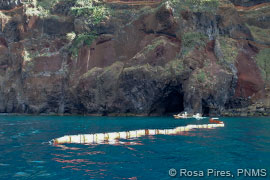 |
|
|
An inflatable boom being positioned at a simulated monk seal cave. |
The exercise’s main objective was to develop a local oil spill response contingency planning capability, involving all stakeholders affected either directly or indirectly by such an accident. Response scenarios which took place at the Nature Reserve included offshore recovery and shoreline cleanup.
In the offshore recovery scenario, monk seal protection became a focus of efforts, with participants being trained on how to safeguard from oil contamination one monk seal cave with inflatable barriers. This operation has assumed extreme importance since oil tankers regularly sail through Madeiran waters. In 1994 an oil spill occurred on the Madeiran island of Porto Santo, although it did not have negative impacts on neighbouring monk seal habitat at the Desertas Islands.
Drafting a ‘protocol for co-ordinated action in emergencies’, such as an oil spill, is one of the recommendations of the Action Plan for the Recovery of the Mediterranean Monk Seal in the Eastern Atlantic, defined under the Bonn Convention (Working Group of the Mediterranean Monk Seal in the Eastern Atlantic, 2005). – Rosa Pires, Parque Natural da Madeira Service.
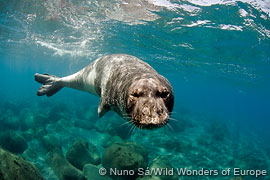 |
|
|
|
Wild Wonders of Europe photographer Nuno Sá has been on assignment in Madeira’s Desertas Islands, building up a photographic dossier of the nature reserve’s outstanding landscape as well as its fauna and flora, both on land and underwater.
Exceptionally, Nuno also received permission from the Parque Natural da Madeira Service to dive with and photograph the monk seals of the Desertas in their natural habitat. “In the end the seals approached me – it was absolutely amazing!” reports Nuno.
Nuno Sá’s blog and some of his photos from the Desertas, can be found on the Wild Wonders website.
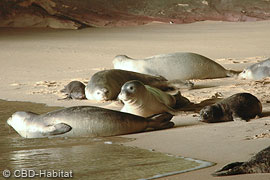 |
|
|
|
There are still two months to go until the end of the year but 48 pups have already been born in the Coast of the Seals so far in 2009 – the same number as occurred in 2006, when a baby boom dramatically increased pup production levels at the colony (see Notable increase of newborn pups at Cabo Blanco in 2006, The Monachus Guardian 9 (2): November 2006). We still expect several more births this season, so we hope to exceed this year the level of 50 births.
The breeding season began in May and the maximum number of births until now has taken place in August and September with 13 births each.
Where pup mortality is concerned, only 10 pups have died or disappeared to date, representing a Pup Mortality Rate of 21% of the total number of births, the lowest level recorded at present in this colony. Nevertheless, the season has not ended and many pups have not moulted yet, so this rate may change in the next months.
Also, a new group of young females were identified this year as reproductive individuals, increasing the reproductive potential of the colony. – Moulaye O.Haye, Miguel A. Cedenilla and Hamdi M’Barek, CBD-Habitat Foundation.
In the early morning of 21 September a guard of the Coast of the Seals Reserve, while on his daily inspection, discovered a pup alive and alone on a beach south of the breeding caves.
Stormy conditions during the previous days must have swept the pup out of the breeding cave into the open sea. The current, together with the animal’s disorientation, carried the newborn seal to the first large open beach south of the cliffy area that forms the coast.
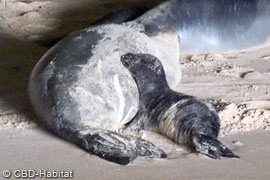 |
|
|
Reunited. |
It was a male pup, only 1-3 days of age, still with the umbilical cord complete. The seal had not previously been detected or identified by CBD-Habitat Foundation technicians.
Considering the age of the pup, and that the afternoon before, a reproductive female had been observed crying insistently and going in and out of one of the main reproductive caves – a common behaviour of a mother seeking its pup – we acted immediately to reunite the two.
The pup was taken to the encampment, where it was physically examined to ensure that it was in good health and well hydrated. It was measured and tagged (Temple Tag) in both rear flippers, and was given the identification number P479. Two CBD-Habitat technicians then carried the pup into the cave where the female had been observed the day before. With great care, the pup was introduced via a lateral access, without disturbing the seals that were occupying the cave. It was then freed on one side of the inner beach, and left to acclimatise itself to its surroundings in the hope that its own behavioural instincts would take over. A few minutes later it began to move to the centre of the beach, crossing other seals and, soon afterwards, went to the water of the interior tunnel, where it joined a mother-pup pair. The trio came out onto the beach; the female then returned to the water leaving both pups resting together on the sand. They remained like this until dawn.
The following morning the pup was detected close to an adult female showing signs of mutual acceptance. The female, probably its mother, was identified two days later as a known reproductive female and it could be confirmed that it was nursing the pup. An interesting point was to see later on that another female was nursing it as well. Today, the pup is one and a half months of age, near to moult and in perfect condition thanks to these two females that are raising it together. – Miguel A. Cedenilla and Moulaye Haye, CBD-Habitat Foundation.
At 22:37 on 3 August, the Coast of Seals Reserve surveillance team, which occupies the encampment located over the main monk seal breeding cave, sensed an earth tremor, which did not last long.
When on the following morning the TV monitoring system was switched on, what was assumed to have been an earthquake the day before was actually revealed to be an enormous collapse in the inner left side of cave 1, mainly in the flooded tunnel that extends to the inner beach. Fortunately, the entrance to the cave was not blocked and seals could enter and exit without difficulty.
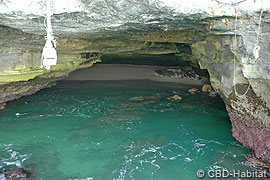 |
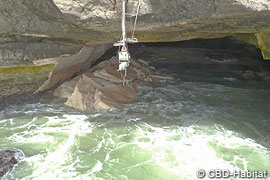 |
|
|
Before and after the collapse. |
||
Five pups were inside the cave at the time of the collapse, although fortunately all were observed to be unharmed in the days that followed. It cannot be confirmed if adults were in the area at that time or if they had been affected by the collapse.
Now, more than two months after the incident, seals still use the cave as they did before, and have given birth to many pups there since the collapse. However, we are observing erosion and sedimentary changes to the beach inside the cave. The narrow entrance and posterior wider tunnel had the effect of making waves lose energy after passing through the entrance, depositing sand on the beach. Now, with the collapse narrowing the tunnel, waves seem to enter with more force towards one side of the beach, causing a higher erosion there. At the opposite point, the part of the beach protected now by the collapse is accumulating more sand, being more protected from sea conditions. As expected, seals now prefer to rest behind the rocks of the collapse, probably because of the milder wave action there.
A special monitoring protocol for the evolution of the beach has been established in order to detect the trends in its further erosion and sedimentation dynamic. – Hamdi O. M’Barek and Mercedes Muñoz, CBD-Habitat Foundation.
On 12 August 2009, a well known reproductive female at Cabo Blanco began showing signs of giving birth. Following standard practice, CBD-Habitat staff began recording the event. After a few minutes, the technician observed that the back flippers of the pup were emerging first.
The traumatic birth lasted much longer than usual (31 minutes), but finally a male pup emerged, apparently in good shape. Fortunately, two months later, both mother and pup are fine and healthy.
This is the first time that this type of birth has been recorded in Cabo Blanco.
The edited video, presented here, shows the complete sequence. – Mercedes Muñoz and Moulaye O. Haye, CBD-Habitat Foundation.
Mediterranean News continues with Turkey...
Copyright © 2009 The Monachus Guardian. All Rights Reserved |